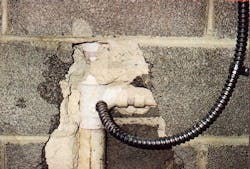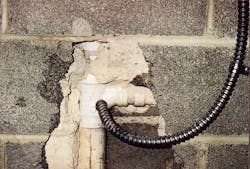Return of Code Clusters: Master Plumber Finds Leak in Electrical Conduit
Code Clusters is a fond look back at some of the most interesting and outlandish Code violations published in the pages of EC&M magazine over the past 15 years — the item below is the eighth in a series of 10. Questions? Comments? We'd love to hear your feedback! Post your thoughts in the box below.
Master plumber finds leak in electrical conduit
All references are based on the 1999 edition of the NEC.
An electrical system chief of construction took this photo during the electrical construction phase in a school addition. Both the plumbing and electrical system branch circuit raceway were installed in the same area for this drinking water cooler. The electrician drilled through the wall and installed some reduced wall aluminum ½-in. flexible metal conduit to supply a 125V, 20A rated receptacle on the other side for supply to the equipment. This situation went undetected for quite some time.
After numerous complaints by workers who found puddles of frozen water in the unheated hallway during construction, the plumber broke open the wall and discovered the annoying leak was caused by this huge hole in the drinking water cooler’s nonmetallic plumbing system. This is a very unusual situation caused by human error. However, the electrician who drilled the hole may have encountered a serious electrocution hazard if the drill bit penetrated an energized circuit conductor in the metal raceway.
Many electrical inspectors have called for or added an ordinance to create a specific rule to require a ground fault circuit interrupter be installed to protect a “drinking water fountain.”
Sec. 680-1 (FPN) in the ’96 NEC indicates the term “pool” is not intended to include drinking water fountains.
The ’99 NEC deleted the FPN and now defines a “fountain” under Sec. 680-4, “As used in this article, the term includes fountains, ornamental pools, display pools, and reflection pools.” It does not include “drinking fountains.”
Question: Was there a reason for deleting the word “water”? This raises an interesting point because the ’99 NEC includes rules that address “drinking water coolers.” See Secs. 440-3(c); 440-13; and 440-22(b), Exception No. 2.
I could not find any other reference in the NEC that mentions a “drinking fountain.” I believe a proposal for the 2002 NEC is in order to change the term to “drinking water cooler.” So now what should we do? I would start calling for GFCI protection for “drinking water coolers!”

